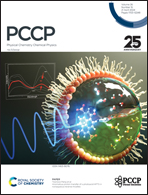Chemisorption of silicon tetrachloride on silicon nitride: a density functional theory study†
Abstract
We studied the chemisorption of silicon tetrachloride (SiCl4) on the NH2/NH-terminated silicon nitride slab model using density functional theory (DFT) for atomic layer deposition (ALD) of silicon nitride. Initially, two reaction pathways were compared, forming HCl or NH3+Cl− as a byproduct. The NH3+Cl− complex formation was more exothermic than the HCl formation, with an activation energy of 0.26 eV. The –NH2* reaction sites are restored by desorption of HCl from the NH3+Cl− complexes at elevated temperatures of 205 °C or higher. Next, three sequential ligand exchange reactions forming Si–N bonds were modeled and simulated. The reaction energies became progressively less exothermic as the reaction progressed, from −1.31 eV to −0.30 eV to 0.98 eV, due to the stretching of Si–N bonds and the distortion of the N–Si–N bond angles. Also, the activation energies for the second and third reactions were 2.17 eV and 1.55 eV, respectively, significantly higher than the 0.26 eV of the first reaction, mainly due to the additional dissociation of the N–H bond. The third Si–N bond formation is unfavorable due to the endothermic reaction and higher activation energy. Therefore, the chemisorbed species would be –SiCl2* when the surface is exposed to SiCl4.

- This article is part of the themed collection: Celebrating International Women’s day 2025: Women in physical chemistry


 Please wait while we load your content...
Please wait while we load your content...